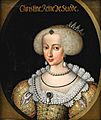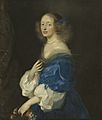Christina of Sweden facts for kids
Quick facts for kids Christina |
|
|---|---|

Portrait by Jacob Ferdinand Voet
|
|
| Queen of Sweden | |
| Reign | 6 November 1632 – 6 June 1654 |
| Coronation | 20 October 1650 |
| Predecessor | Gustav II Adolf |
| Successor | Charles X Gustav |
| Born | 18 December [O.S. 8 December] 1626 Stockholm, Sweden |
| Died | 19 April 1689 (aged 62) Rome, Papal States |
| Burial | 22 June 1689 Saint Peter's Basilica, Vatican City |
| House | House of Vasa |
| Father | Gustavus Adolphus of Sweden |
| Mother | Maria Eleonora of Brandenburg |
| Religion | Roman Catholic Christianity prev Lutheran Christianity |
Christina (born December 18, 1626 – died April 19, 1689) was the Queen of Sweden from 1632 to 1654. She was the only child of King Gustav II Adolph and his wife Maria Eleonora of Brandenburg who survived to adulthood. Christina became queen when she was just six years old, after her father died in the Battle of Lützen. However, she only started ruling the country fully when she turned 18.
Christina was known as one of the smartest and most educated women of her time. She loved books, old writings, paintings, and sculptures. She was very curious about many subjects like religion, philosophy (thinking about life), mathematics, and even early science (alchemy). She invited many smart people and scientists to Stockholm, hoping to make it a center for learning, like ancient Athens.
She had a strong personality and surprised many people when she chose not to marry. In 1654, she made a big decision: she gave up her throne and changed her religion to Catholicism. This was a very unusual step for a Swedish monarch at that time. After this, she changed her name to Christina Alexandra.
When she was 28, Christina, sometimes called the "Minerva of the North" (meaning she was very wise), moved to Rome. Even though she was no longer a queen, she became a very important supporter of theater and music in Rome. She helped many Baroque artists, composers, and musicians.
Christina was a guest of five different popes and became a symbol of the Counter-Reformation (a movement within the Catholic Church). She is one of the few women buried in the Vatican grotto, a special burial place for popes. Her unique lifestyle, including her way of dressing and behaving, has been shown in many books, plays, operas, and movies.
Contents
Early Life and Education
Christina was born in Stockholm, Sweden, in 1626. Her father, King Gustav II Adolph, was a famous military leader. He was very proud of Christina and made sure she received an excellent education. She learned many languages, including Latin, Greek, and French. She also studied history, philosophy, and science. She was a very quick learner and loved to read.
When her father died in battle, Christina became queen. Because she was so young, a group of important people, called a regency council, ruled Sweden for her. During this time, she continued her studies and prepared to take on her royal duties.
Becoming Queen
Christina officially became the ruler of Sweden when she turned 18 in 1644. She was a very active queen and took a great interest in how the country was run. She worked hard to end the Thirty Years' War, which had been going on for a long time and involved many European countries. She helped negotiate the Peace of Westphalia in 1648, which brought peace to Europe.
She also focused on improving education and culture in Sweden. She invited many scholars, artists, and musicians to her court in Stockholm. She built a large library and collected many valuable artworks. Her goal was to make Sweden a leading cultural center in Europe.
Abdication and Life in Rome
In 1654, Christina made the surprising decision to give up her throne. She explained that she wanted to live a more free life and practice her new Catholic faith openly. After her abdication, her cousin, Charles X Gustav, became the new King of Sweden.
Christina then traveled to Rome, where she spent most of the rest of her life. She was welcomed by the Pope and became an important figure in Roman society. She hosted many gatherings where artists, writers, and thinkers would meet and discuss ideas. She continued to support the arts and sciences, even without a kingdom.
Christina lived an independent life in Rome until her death in 1689. She was buried in St. Peter's Basilica, a very important church in the Vatican.
Images for kids
-
Queen Christina (at the table on the right) in discussion with French philosopher René Descartes. (Romanticized painting by Nils Forsberg (1842-1934), after Pierre Louis Dumesnil
-
Bust of Christina by Giulio Cartari in Palacio Real de La Granja de San Ildefonso
-
Ebba Sparre married in 1652 a brother of Magnus Gabriel de la Gardie. Painting by Sébastien Bourdon
See also
 In Spanish: Cristina de Suecia para niños
In Spanish: Cristina de Suecia para niños




















